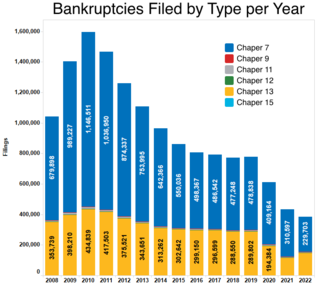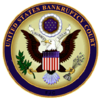Bankruptcy is a legal process through which people or other entities who cannot repay debts to creditors may seek relief from some or all of their debts. In most jurisdictions, bankruptcy is imposed by a court order, often initiated by the debtor.
Chapter 11 of the United States Bankruptcy Code permits reorganization under the bankruptcy laws of the United States. Such reorganization, known as Chapter 11 bankruptcy, is available to every business, whether organized as a corporation, partnership or sole proprietorship, and to individuals, although it is most prominently used by corporate entities. In contrast, Chapter 7 governs the process of a liquidation bankruptcy, though liquidation may also occur under Chapter 11; while Chapter 13 provides a reorganization process for the majority of private individuals.
Chapter 7 of Title 11 U.S. Code is the bankruptcy code that governs the process of liquidation under the bankruptcy laws of the U.S. In contrast to bankruptcy under Chapter 11 and Chapter 13, which govern the process of reorganization of a debtor, Chapter 7 bankruptcy is the most common form of bankruptcy in the U.S.
Personal bankruptcy law allows, in certain jurisdictions, an individual to be declared bankrupt. Virtually every country with a modern legal system features some form of debt relief for individuals. Personal bankruptcy is distinguished from corporate bankruptcy.
Debt restructuring is a process that allows a private or public company or a sovereign entity facing cash flow problems and financial distress to reduce and renegotiate its delinquent debts to improve or restore liquidity so that it can continue its operations.

In the United States, bankruptcy is largely governed by federal law, commonly referred to as the "Bankruptcy Code" ("Code"). The United States Constitution authorizes Congress to enact "uniform Laws on the subject of Bankruptcies throughout the United States". Congress has exercised this authority several times since 1801, including through adoption of the Bankruptcy Reform Act of 1978, as amended, codified in Title 11 of the United States Code and the Bankruptcy Abuse Prevention and Consumer Protection Act of 2005 (BAPCPA).
In accounting, insolvency is the state of being unable to pay the debts, by a person or company (debtor), at maturity; those in a state of insolvency are said to be insolvent. There are two forms: cash-flow insolvency and balance-sheet insolvency.
A trustee in bankruptcy is an entity, often an individual, in charge of administering a bankruptcy estate.
A fraudulent conveyance or fraudulent transfer is the transfer of property to another party to prevent, hinder, or delay the collection of a debt owed by or incumbent on the party making the transfer, sometimes by rendering the transferring party insolvent. It is generally treated as a civil cause of action that arises in debtor/creditor relations, typically brought by creditors or by bankruptcy trustees against insolvent debtors, but in some jurisdictions there is potential for criminal prosecution.
The Bankruptcy and Insolvency Act is one of the statutes that regulates the law on bankruptcy and insolvency in Canada. It governs bankruptcies, consumer and commercial proposals, and receiverships in Canada.
An unfair preference is a legal term arising in bankruptcy law where a person or company transfers assets or pays a debt to a creditor shortly before going into bankruptcy, that payment or transfer can be set aside on the application of the liquidator or trustee in bankruptcy as an unfair preference or simply a preference.
As a legal concept, administration is a procedure under the insolvency laws of a number of common law jurisdictions, similar to bankruptcy in the United States. It functions as a rescue mechanism for insolvent entities and allows them to carry on running their business. The process – in the United Kingdom colloquially called being "under administration" – is an alternative to liquidation or may be a precursor to it. Administration is commenced by an administration order.
The history of bankruptcy law in the United States refers primarily to a series of acts of Congress regarding the nature of bankruptcy. As the legal regime for bankruptcy in the United States developed, it moved from a system which viewed bankruptcy as a quasi-criminal act, to one focused on solving and repaying debts for people and businesses suffering heavy losses.
Bankruptcy in Irish Law is a legal process, supervised by the High Court whereby the assets of a personal debtor are realised and distributed amongst his or her creditors in cases where the debtor is unable or unwilling to pay his debts.
The Companies' Creditors Arrangement Act is a statute of the Parliament of Canada that allows insolvent corporations owing their creditors in excess of $5 million to restructure their businesses and financial affairs.

British Virgin Islands bankruptcy law is principally codified in the Insolvency Act, 2003, and to a lesser degree in the Insolvency Rules, 2005. Most of the emphasis of bankruptcy law in the British Virgin Islands relates to corporate insolvency rather than personal bankruptcy. As an offshore financial centre, the British Virgin Islands has many times more resident companies than citizens, and accordingly the courts spend more time dealing with corporate insolvency and reorganisation.

Cayman Islands bankruptcy law is principally codified in five statutes and statutory instruments:
In relation to corporate insolvency, modified universalism or modified universality is a legal concept relating to the general principle that national courts should strive to administer the estates of insolvent companies in the spirit of international comity. The broad concept is that it is desirable for cross-border insolvencies to be managed by a single officeholder as a single estate rather than a series of piecemeal and unconnected proceedings in different countries, and that this should be recognised globally. In practice, whilst many countries will recognise foreign bankruptcy proceedings, in many instances the courts have set some limits on the recognition of insolvency proceedings, such that the courts apply this principle of modified universality whereby the courts retain a discretion to assess whether the overseas proceedings are consistent with their own principles of justice and public policy. But, subject to that safeguard, the courts will generally defer to the proceedings which are regarded as the "main proceedings" for the purposes of getting in and distributing assets of the insolvent company. The principal is referred as to modified universalism in that it strives to find a balance between purely territorial bankruptcy systems, and entirely universal international bankruptcy system.
The UNCITRAL Model Law on Cross-Border Insolvency was a model law issued by the secretariat of UNCITRAL on 30 May 1997 to assist states in relation to the regulation of corporate insolvency and financial distress involving companies which have assets or creditors in more than one state.
Cross-border insolvency regulates the treatment of financially distressed debtors where such debtors have assets or creditors in more than one country. Typically, cross-border insolvency is more concerned with the insolvency of companies that operate in more than one country rather than bankruptcy of individuals. Like traditional conflict of laws rules, cross-border insolvency focuses upon three areas: choice of law rules, jurisdiction rules and enforcement of judgment rules. However, in relation to insolvency, the principal focus tends to be the recognition of foreign insolvency officials and their powers.



